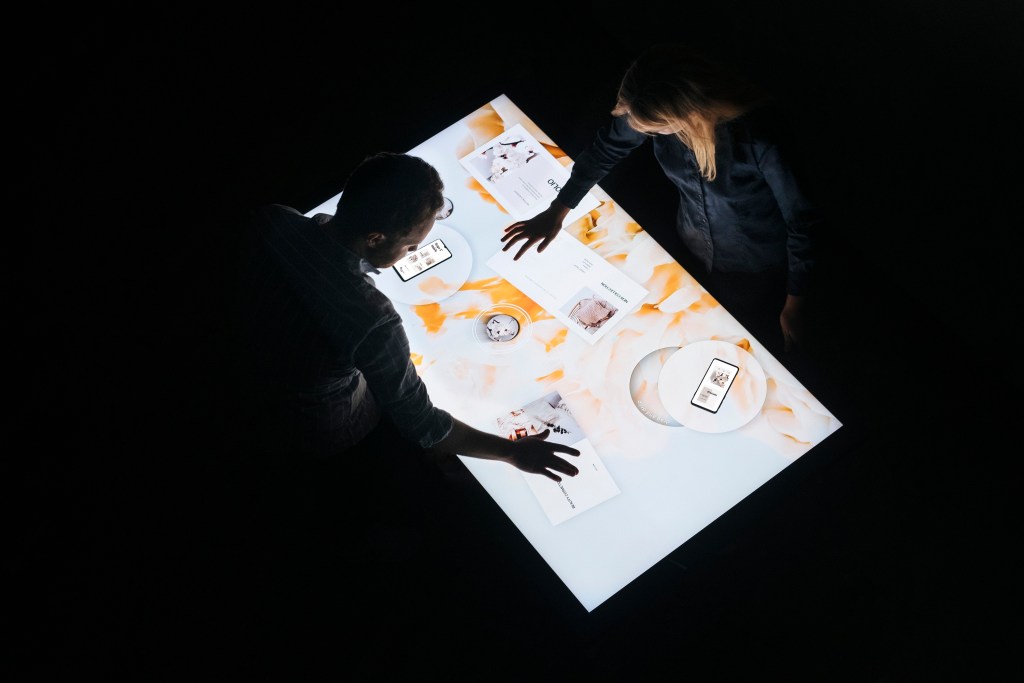

As the first widely used multi-touch object recognition on the market, MultiTaction’s Codice™ markers have long been a favourite in showrooms, brand spaces and exhibitions. Objects, markers, or tokens add an exciting new level of digital interaction to meetings and presentations. We too used MultiTaction systems and object recognition for several years. But with the Finnish company recently announcing a re-organisation, we and our partners are receiving more and more enquiries looking for alternatives to MultiTaction object recognition technology. In this post, we give a brief introduction to this type of recognition and present a unique, reliable alternative.
The Codice™ system is an optical, camera-based recognition system that runs on MultiTaction's ClearSight touch displays. In short, this means that infrared cameras visually recognise printed patterns, which are linked to actions in the application, allowing the touch display to identify the object and show personalised content, for example. Anything that changes the light levels entering the cameras, such as fingers, styluses, or objects, can be recognised by the screens, and the position can be detected using triangulation.
Optical touch systems can be built with almost no bezel. The markers themselves are simple and inexpensive to produce and can be printed on almost any surface. The markers are also small and can be made to fit the size of a credit card. Because cameras are used to recognise fingers and objects, it is also very easy to scale and adapt the recognition to different screen sizes, making it a good choice for very large displays.

Like any technology, optical recognition is not without its limitations. With such large format systems, users quickly realise that the touch displays only have Full HD instead of UHD / 4K resolution. In general, optical systems are dependent on the light situation of the environment, so that direct or changing lighting, for example at trade fairs or due to the position of the sun, can lead to a complete failure of the touch function and thus also of object recognition. Depending on the design of the display, camera-based technologies are also more susceptible to "blind spots" in which touches or objects are not recognised because, for example, a camera has failed or moved slightly, making a new calibration or replacement necessary.
At Interactive Scape, we only use projected capacitive (PCAP) touch technology. It’s the most widely used sensing technology for multi-touch, and it enables the most flexible and reliable object recognition technology on the market. Scape X® technology allows the recognition of all conductive objects, including smartphones and tablets, using artificial intelligence and neural networks. The most significant advantage is the ability to recognise completely transparent tags, which can be attached to any product or object. Just like Codice™ markers, the tags have an ID which is then linked to digital content or actions in the application via the TUIO protocol. The tags easy to apply and are so thin and transparent that they are almost invisible to the eye, meaning they don’t distract visitors from the tagged object itself.

PCAP technology detects changes in the capacitive field of the touch sensors and does not use cameras, so recognition is reliable regardless of ambient light, very robust and requires no calibration. Even in rooms with a lot of sunlight or even outdoors, sudden changes in lighting conditions do not disturb capacitive sensors. We have also found that capacitive recognition is the most sensitive and accurate option, causing no false-positive touches, unlike optical systems, and has very high recognition stability, speed and angular accuracy. This allows intuitive gestures to interact with the content displayed on the screen, such as rotating an object to scroll through content.
This type of object recognition technology works particularly well on horizontal surfaces, and allows a wider range of object types, making it a popular choice for museums, exhibitions, brand spaces and experience centres. It is also a useful tool in collaborative work, smart planning and decision-making. The main disadvantage compared to optical systems is that current capacitive displays have a more noticeable bezel around the edge of the display - though some screens, like Displax's TILE, do offer very thin bezels. The slightly thicker bezels can detract from the aesthetic of larger installations where multiple displays are connected.

Switching to capacitive touch and object recognition is much easier than one might think. Since the interfaces between hardware and software remain the same, existing software can be easily transferred once the new equipment is purchased.
All touch and object recognition technologies offer benefits and disadvantages depending on the specific project or use case, and careful research is required before investing in hardware. For an in-depth review of the technologies available, check out our comparison of the most common types of touch recognition technology. As a leading supplier of object recognition technology, we are always happy to help you with our know-how and experience – regardless of whether you want to use our applications, those of a market competitor or develop one yourself. Feel free to get in touch or book a demo with us to discuss your questions or project ideas!